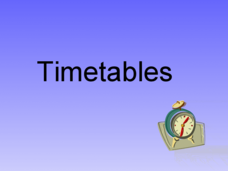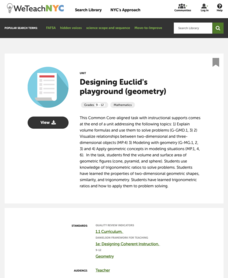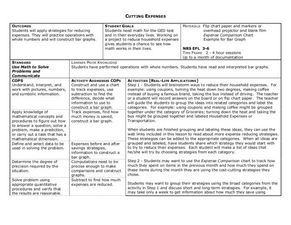Consumers Energy
The Cost of Electricity
How much is your toaster costing you every day? Young environmentalists calculate the monetary costs of household appliances based on their average consumption of wattage.
Curated OER
Timetable Problems
Learning how to read a schedule and determine when you will depart and arrive is an everyday skill that builds competency in chart reading, subtraction, elapsed time, and counting on. Learners discuss how to solve timetable problems and...
New York City Department of Education
Designing Euclid’s Playground
Create a geometric playground. Pupils work through a performance task to demonstrate their ability to use geometric concepts to solve everyday problems. The accompanying engineering design lessons show teachers how the assessment works...
SEN Teacher
Clock Bingo
Telling time is an everyday occurrence, but with this resource, pupils can tell time and win! Print out customized bingo cards based on your learners' skill level by choosing different time intervals and number of cards per sheet. There...
Illustrative Mathematics
Banana Pudding
Making banana pudding despite misplacing your one-cup measuring cup is easy as long as you can find your quarter-cup measuring cup! This real-life activity provides a good opportunity for learners to interpret division of a whole...
S2tem Centers SC
Investigating Chance Processes of Probability
How likely is it that the school cafeteria will serve chicken tomorrow? Discover the concept of probability with the roll of the dice. Pupils evaluate the liklihood of several statments about everyday life. Then, a mathematical...
Curated OER
Design Patterns in Everyday Life
Students find symbols and patterns in everyday life. In this patterns lesson, students break into groups and look for specific patterns and symbols. Students record their findings. Students create a graphic organizer with the information.
Curated OER
Fractions Everyday
Students investigate fractions through interactive videos and hands-on activities and class made models.
Curated OER
Everyday Mathematics at Home
Send this information home with your young learners. Adults, siblings, or friends can help youngsters learn how to measure! This gives basic tips and suggests having the child draw a series of lines, and then use their 10-centimeter...
Curated OER
Everyday Mathematics: Coins
In this counting coins worksheet, students receive help from an adult to find the total value for the pictured coins. The objective is to enhance students' counting money skills and skip counting skills.
Curated OER
Solve Time and Money Word Problems in Everyday Life
Fourth graders solve real life problems involving time and money. They write their own math word problems. Students use addition, subtraction, multiplication and fractions to solve math problems.
Curated OER
Telling Time as an Everyday Use of Numbers
How can we estimate time? Have your young mathematicians make a clock. Then they compare and contrast types of clocks. They practice writing times in two different ways and make a book about telling time.
Curated OER
Math In Everyday Life
Second and third graders solve word problems involving both time and money. First the class works together to solve basic addition, subtraction, multiplication, and simple fraction problems (these examples are provided). After solving...
Curated OER
Everyday Heroes You Can Be One, Too
Students listen to a read aloud of Alan Baker's, White Rabbit's Color Book while identifying shapes and lines throughout the book. They use shapes and different types of lines to create a bunny of their own. They must use five shapes to...
Curated OER
My Foot and the Standard Foot
Young mathematicians put one foot in front of the other as they learn how to measure length in an elementary math lesson. Using paper cutouts of their own feet, children measure classroom objects as they discover the importance of...
Curated OER
A Model Solar System
If Earth is modeled by a grapefruit, what planet could be represented by a golf ball? This activity uses everyday and not-so-everyday objects to create a model of the Solar System.
Curated OER
Perceived Risks
Students rank a list of everyday risks to compare with classmates. They rate each risk on both its ability to be controlled and its observability in the environment. Results are graphed.
Curated OER
Branding Circles, Squares, Rectangles, Triangles
Compare and classify 2-D shapes! Kindergarteners inspect the attributes of plane shapes and examine shapes in everyday life. They label the circles, squares, rectangles, and triangles they find. This is the website where you can find the...
Illustrative Mathematics
Counting Overview
Develop automatic, meaningful counting skills with your class by using everyday classroom/school items, objects, and opportunities. Counting skills should be practiced during the year using objects and items they are familiar with and...
Math Can Take You Places
Picture This
Engage scholars in a ratio lesson that employs real-world scenarios. Learners will compare the length and width of pictures and use a table to identify ratio patterns. They watch "Math Can Take You Places" and discuss jobs that use math...
Skills Workshop
Ratio, Scale, and Proportion
Converting units is an excellent example of how math relates to our everyday tasks. The resource prompts mathematicians to use baking, cooking, and other daily activities to discover how to make larger quantities of...
Curated OER
Terrific Tessellations
Students construct tesselations that fosters their ability to create, transform, and critique their own piece of work. This allows them to become aware of repeated patterns in math, and connect these patterns to artwork.
Curated OER
Cutting Expenses
Students explore budgeting. For this finance and math lesson, students brainstorm ways in which households could save money. Students view websites that give cost reducing ideas. Students complete an expense comparison chart and use the...
Curated OER
Making Simple Conversions
Young scholars explore the concept of measurement as it relates to equivalencies. They complete simple conversions using visual models of measurement units, and record their answers in a two-column table.
Other popular searches
- Everyday Mathematics
- Math in Everyday Life
- Everyday Math Skills
- Everyday Math Grade 5
- Everyday Math Number Sense
- Everyday Math Fourth Grade
- Everyday Math Grade 2
- Grade 1 Everyday Math
- Everyday Mathematics Arrays
- Algorithms in Everyday Math
- Everyday Math 3
- Everyday Mathematics Review























